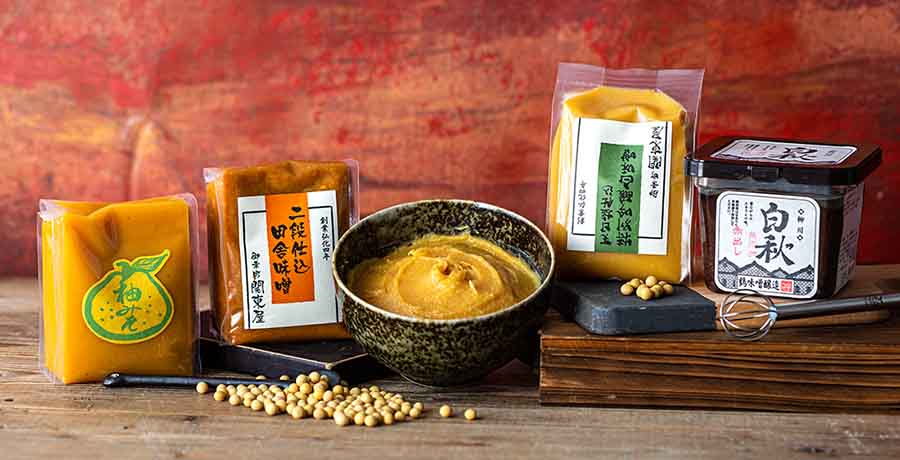
The first thing to know about different types of miso
The starting point as you delve deeper into the world of different miso styles must be this…The lighter and whiter the miso is, then the younger, fresher, sweeter and more delicate the flavour will be. The Darker the miso, the longer it has fermented. This gives it a richer, fuller, savoury, saltier umami flavour. ‘Both delicious, both have lots of applications.’ Says Chef Tim Anderson in our video.
However, categorising just by White, Yellow and Red (Pale to Dark) only tell you about the length of the fermentation process. There’s so much more to know!
At the Wasabi Company we’ve carefully selected a range of the very best artisan miso available from highly respected producers in Japan. We have a miso to complement every style of cooking, whether you’re a top chef or a keen cook wanting to explore. Miso isn’t only good for Japanese cuisine, it’s a hero ingredient that can do magic with pretty much every kind of western recipe too!
Here’s a deeper dive into the different types of miso we have selected for you at The Wasabi Company, which also happen to be our favourites!
6 Types of Miso That Make Magic Happen In Your Kitchen
1. White - Shiro Miso - Usually Made with Rice (but not always)
If you’re looking for a delicate and subtle, sweeter umami flavour, then white shiro miso is the one to choose. Add to dressings for delicate and simple salads such as with leaves and cucumber,. Marinade vegetables to bring out their flavour. The combination of sweet, salty and umami flavours goes particularly well brushed on to fatty fish such as salmon and cod. A great secret ingredient for all kinds of western dishes.
Our most popular miso White Miso is made by the artisans at Tsurumiso. Or if you’re getting really serious and want the best of the best, try the White Shiro Miso from the craftsmen at Kantoya, They produce their koji by hand and are renowned among the world’s top chefs to be one of the best miso producers in Japan.
2. Awase Mixed Barley and Rice Miso - Medium Aged
This is the miso that Chef Tim Anderson recommends as your ‘general purpose’ all round miso. It combines the delicate flavour of white shiro miso with the richer taste of red. This is also a great miso for first-timers or anyone wanting to start experimenting more with miso.
Our Awase Barley Miso is also made by the artisan producers Tsurumiso.
3. Barley (Mugi) Miso
Barley Miso usually has a medium to long term ferment and delivers a strong and powerful punch of umami. Often chunkier in texture, but not always. Barley Miso is the type that is traditionally used in Miso soup, with its hearty, depth of savoury flavour it’s perfect for warming your cockles!
Our Mugi Barley Miso is produced by Maruhide Shoyu, another serious producer who takes their craft seriously. This Barley Miso has a particularly intense flavour and aroma as it has fermented for two years.
4. Rustic Style Miso
Our rustic style miso has been fermented twice, the first time to give a light flavour and the second to enrich the sweet and salty taste and develop a rich soy aroma.
Our Double Fermented Rustic Miso made by Kantoya, is widely known as one of the best miso in Japan. A careful balancing of lightness of flavour (unusually only rice koji is used in this one) and deep soy aroma make this robust rustic miso as exceptional as it is unusual. Try for a really, really special miso soup. This type of miso contains an enzyme that creates a very delicious reaction when used to marinate fish or meat for a minimum of 12 hours. Try it - you’ll be amazed!
5. Red - Akamiso
Fermented for longer with less koji and more Barley or sometimes, in the case of our aka dashi miso, only soybeans.
Our Akadashi by Kantoya in Kyoto was picked out by Tim Anderson as one of his favourites. We also have Red Miso by Tsurumiso available.
“This is a long-aged miso, you can tell, it’s very dark, very very aged. It’s really rich, very salty and very delicious. In the ballpark, flavour-wise… it’s vegemite, marmite, bovril, really, really savoury, almost beefy. It’s also got a fruitiness like kalamata olives a little bit of balsamic vinegar flavour. It’s going to be good with stronger flavoured ingredients. For me, I’d say it’s perfect with lamb chops, or even braised beef or stew, chilli. You could also try it with a salted caramel sauce, it’s not just for savoury food and that goes for the yuzu and every kind of miso too. If a sweet recipe calls for salt try swapping for miso. If it’s for caramel or toffee or chocolate then definitely go for a dark brown aged miso like this.”
6. Yuzu Miso

Flavoured styles such as our yuzu miso are not traditional and they contain other ingredients to balance the flavours.
Our Yuzu Miso is another one Tim picked out to talk about in more depth. “This one is mixed with yuzu, the greatest citrus fruit of all time, plus with some sugar, sweeteners such as mirin and sake to round off and balance the flavour. You can use this straight out of the pouch and season all kinds of things or just on its own.”
“This is really good, this is mellow and sweet, really sweet, it has the great yuzu aroma, it’s quite sticky from the sugar, it reminds me of lemon curd. It’s really, really smooth and citrussy, this would be fantastic with fish and shellfish, but also you could balance it out with a little vinegar or yuzu or lemon juice and it would be fantastic with chicken and vegetables. A little bit of sesame oil in here too along with some vinegar would make a perfect salad dressing.
“There’s a whole world of miso to explore- so find your favourite! That's what I always do!” Chef Tim Anderson
That’s a wrap on our miso round-up! Which do you think you’ll enjoy using the most?
● What is Miso? How is miso made, how do you use miso and where does miso come from?
● Browse our range of premium and artisan miso from some the of the world’s most famous producers
● Learn more about all our Artisanal Japanese Cooking Ingredients





